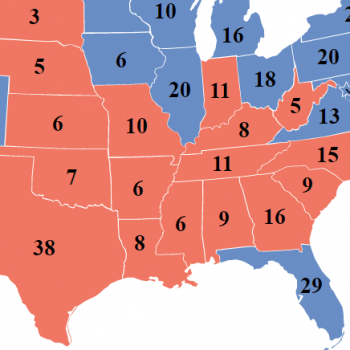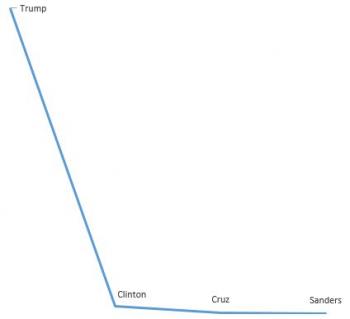Ask Professor Puzzler
Do you have a question you would like to ask Professor Puzzler? Click here to ask your question!

"Good morning, I've been seeing some things lately about Donald Trump being in the Bible. Here are a few:
King Cyrus was in Isaiah 45, and Trump is the 45th president, so Trump is the 'new' Cyrus.
Donald Trump was born 700 days before Israel declared independence.
777 days after Donald Trump's birthday, Israel was 77 days old.
Israel's 70th anniversary will come exactly 700 days after Donald Trump's 70th birthday.
Donald Trump won the election on Netanyahu's 7th year, 7th month, 7th day in office.
What does all this mean?"
First of all, none of these things can be described as "Donald Trump being in the Bible." Most of them mention Israel, but the word "Israel" does not automatically make it a "Bible statement." With that in mind, let's talk about these three statements (I know, you're probably thinking "There are five statements, not three!" - you'll see why I say "three").
Statement 1: King Cyrus is discussed in Isaiah 45. He's also discussed in: II Chronicles 36, Ezra 1, 3, 4, 5, and 6, Isaiah 44, Isaiah 45, Daniel 1, 6, and 10. So unless you want to suggest that the first, third, fourth, fifth, sixth, tenth, thirty-sixth, and forty-fourth presidents are also the "new" Cyrus, there's not much point to this statement. Even if you limited it to Isaiah, or limited it strictly to passages that are prophecies, Isaiah 44 comes before Isaiah 45, so that would make Obama the "new" Cyrus.
Statements 2.0, 2.1, and 2.2: These statements are all identical. Once you've stated that Israel declared independence 700 days after Donald Trump's birth, the next two sentences add no new information; they are mathematical restatements of the same equation. The fact that your source had so little clever numerology to share that they had to state the same fact three different ways seems a bit suspicious.
Statement 3: Uh...no? According to several sources, Netanyahu took office (for the second time) on March 31st, 2009. So if his first year in office was 2009, his seventh year was 2015, not 2016. Besides, even if the math had worked out correctly, why did we go to his second term, instead of his first, or third, or fourth?
There are some good lessons to learn here.
- Fact-checking is critical. Statement 3 doesn't pass even a basic fact-check attempt.
- In addition to fact-checking, we must also be able to look at the "bigger picture". The first statement you shared passes the "fact-check" test; Isaiah 45 really is about Cyrus. But the bigger picture is that Cyrus prophecies also exist elsewhere, so 45 is not a special case.
- Sometimes basic mathematical understanding will help keep you from getting "conned" - algebraic understanding lets you see that the middle statements are all the same statement.
- Be wary of statements about x number of months or years ago, because people trying to find interesting connections have a lot of flexibility in how they count. For example, how do you count a year? 365 days? Or are you going to include leap years? Or are you going to simply subtract one from the year number? The answer is: you count it whichever way gives you an interesting result. Similarly, how do you count a month? 30 days? 31? Or do you revert back to the same day a month previous? Do you count your days back FIRST and then your months? Or vice-versa? It actually matters. For example, 7 months and 77 days before November 30th is either February 13th or February 14th, depending on which order you subtract (I'll leave it to the reader to figure out why). Which way do you do it? There is no standard rule, so you do your subtraction, and if it doesn't produce any interesting gems, you cheat and do the subtraction a different way, and you keep doing that until you find something "interesting"
- It's extremely easy to use a date calculator and a "what happened on this date" webpage to find events that seem to "prove" something. For instance, did you know that 666 days before President Trump was elected, ISIS perpetrated a hack against the US Central Command, and 666 weeks before the election, Russian hackers performed a distributed denial of service attack against US interests? Furthermore, 666 months, 666 weeks, and 666 days after Donald Trump's birth, terrorists committed the largest single attack in French history. Do I think that "means" anything? No, I really don't. But I think it means exactly as much as the random facts that someone shared with you.
Incidentally, if you're fascinated by this kind of numerology stuff (and why wouldn't you be? Numerology has managed to incorrectly predict the end of the world about a billion times in the last two thousand years!), you should be an equal-opportunity numerologist; for every web page you find that "proves" through numerology that President Trump is the second coming of a Persian-king-who-was-never-promised-a-second-coming, you can find another web page that "proves" through numerology that he is the anti-Christ.
Numerology is a fascinating subject, but I've studied math and probability for far too long to be swayed by the numerical coincidences that happen on a daily basis around us!
Gloria asked, "Does the popular vote not count if it's a landslide with the electoral college? How does that work?"

Gloria is asking about the presidential elections. We often talk about how much a candidate is "up" in the polls, and that's a measure of the popular vote. For example, as I write this, Secretary Clinton is, according to most polls, up by 5 to 10 percentage points. This means that 5% to 10% more voters are likely to vote for Secretary Clinton than vote for Mr. Trump.
The definition of "landslide" is pretty nebulous; one source said that if one candidate earns 60%, that's considered a landslide. Of course, with the relative unpopularity of the current candidates, that's certainly not likely. However, with Clinton leading significantly over Trump at this point, many are referring to this as a possible landslide.
But even if that's true, does it guarantee a win for Secretary Clinton? No, it does not. Because it is not the popular vote that determines the result of the election. It's the electoral college. Every state is assigned a certain number of delegates who will cast an "electoral vote" on behalf of the people in their state. For example, California, because it is such a populous state, has 55 electoral votes, but Wyoming, because it has a much lower population, only gets 3 electoral votes.
So what does the popular vote decide? It decides who each state's electors must cast their vote for. In other words, if Secretary Clinton wins California, then all 55 Californian electors cast their ballot for her. If Mr. Trump wins Wyoming, then Wyoming's 3 electors vote for him.
It's an all-or-nothing deal in all but two of the states. Maine and Nebraska have rules that allow the electors to have a split between the candidates.
So, doesn't that mean that a landslide in the popular vote would result in a landslide in the electoral college? Not necessarily. To see why, let's break it down into a simple example. Let's pretend that the United States of America consists of only two states. Semi-random selection off a map: Michigan, and its neighbor, Ohio.
Ohio has a slightly larger population than Michigan, and therefore a slightly larger number of electoral college delegates. Ohio has 18, and Michigan has 16. We'll use 2012 statistics and say that 4.9 million people in Michigan will vote in the upcoming election, and 5.6 million Ohioans will vote.
Now, to make our example clear, we're going to depart from what's likely to happen and imagine an extreme scenario for these two states deciding the election. Let's say that Michigan votes overwhelmingly for Secretary Clinton:
Michigan votes for Clinton: 4.0 million
Michigan votes for Trump: 0.7 million
Michigan 3rd party votes: 0.2 million
Let's further suppose that Mr. Trump wins Ohio, but it's a much closer race than Michigan:
Ohio votes for Clinton: 2.7 million
Ohio votes for Trump: 2.8 million
Ohio 3rd party votes: 0.1 million
Who wins this election? Well, Secretary Clinton gets Michigan's 16 electoral votes, because she won the popular vote there, and Mr. Trump gets Ohio's 18 electoral votes, which means Trump wins the election.
But who won the popular vote? Was it a landslide? Let's find out:
Total votes cast: 10.5 million
Total votes for Clinton: 6.7 million, or 63.8%
Total votes for Trump: 3.5 million, or 33.3%
Total 3rd party votes: 0.3 million, or 2.85%
Is this a landslide? I think any reasonable definition of landslide would agree that in this extreme scenario, Secretary Clinton's win in the popular vote was a landslide. But even so, Mr. Trump wins the electoral college vote, 18 to 16, and becomes the next president.
So what happened? What happened is that in the state that supported Clinton, she trounced Trump, but in the state where Trump won, it was a much closer battle. Since it's an all-or-nothing battle in both states, how much she won by is irrelevant to which direction the electors cast their vote.
Now add 48 more states into the mix, and imagine this sort of scenario playing itself out over and over again. Some states are close, some are a blowout, but the electoral votes are (with the Maine/Nebraska exceptions) assigned all-or-nothing regardless of how big the margin was.
Chris, from Maine, points out that this is not just a theoretical exercise: " A president has lost the popular vote but won the electoral college four times, with the most recent being only 16 years ago!"
Finally we get to the issue that a candidate is required to get a majority of the electoral votes (270). What happens if no one hits that magic number is a question for another day.
First of all, I want to make it abundantly clear that this post is not political in nature. It is not an attempt to endorse one candidate, or repudiate another candidate. It is, pure and simple, pointing out how easy it is to misuse mathematics and statistics to try to emphasize a point. Take a look at this image, which is floating around on facebook.

What is the intent of this picture? Well, looking at the caption under the photo, which read, "Who speaks for you? Bernie Sanders 2016," makes it clear that the intent was to show Sanders as a "man of the people" and the rest of them so insanely rich that they are out of touch with the American people.
But the reality is distorted by the image's choice of mathematical language. Specifically, the choice was made to use the text "¾ million" when referring to Cruz's home, instead of the text "750 Thousand." This, I am certain, was deliberate. Because "milllion" sounds massive compared to "thousand," and if they had written "750 Thousand" next to Cruz, people would be much more likely to realize that Cruz is in the same ballpark with Sanders, and not in the same ballpark as Trump, or even Clinton.
To those who are reading quickly, or who didn't do well in math, "¾ million" sounds much larger than "750 thousand," even though the two phrases are expressing exactly the same value.
In mathematical terms, instead of talking about "ballparks" we talk about "orders of magnitude." Two numbers have the same order of magnitude if the larger one divided by the small one is less than 10.
And guess what! Cruz and Sanders have the same order of magnitude. Would you like to see a graph of these values? Here it is:

Notice that compared to Trump, Clinton's homes seem inexpensive, but compared to both of them, Cruz and Sanders are downright indistinguishable*.
Do I care how rich these guys are? Not even a whit. I have no problem with a rich president. I have no problem with a middle class president. I have no problem with a poor president.
I have a problem with people using mathematics to deceive the people who do care about such things. A good piece of advice for you when looking at a set of statistics: take note of all the units given (in this case, "millions" was given as the units throughout, until the very end) and if the units are not consistent throughout, ask yourself why. It may be that there's a good reason, but it could very well be (as in this case) that someone is trying to fool you. To keep things consistent, the graphic creator should either have written the Cruz value as "750 Thousand" or the Sanders value as "3/10 Million."
The person responsible for the graphic probably was hoping for one of the following:
- You slept through the math lessons where your teacher taught you about place value and magnitude.
- You'll be in such a hurry to click "like" that you won't take a moment to remember the lessons you learned.
After all, it's an election year. What did you expect?
* You might be thinking to yourself, "You really think that the difference between a 300 thousand dollar home and a 750 thousand dollar home is not significant?" And if that's what you're thinking, you're sort of missing the point here. The point is that the person who made the graphic was afraid that if he represented the facts in an honest manner, you would think it was an insignificant difference, and so he chose a dishonest path, hoping that your gullibility would do the rest.

